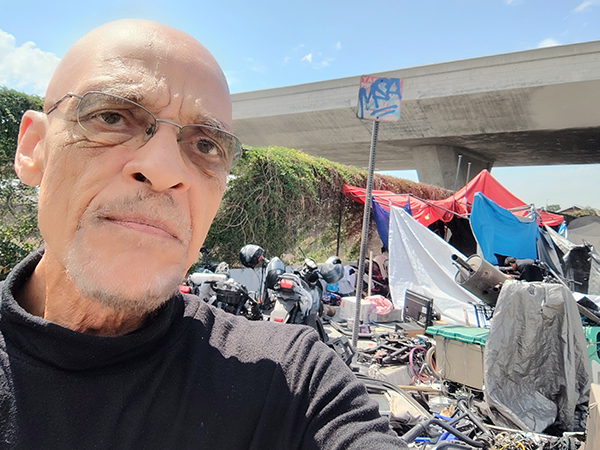Urban Policy Roundtable President Earl Ofari Hutchinson stands near a South L.A. underpass Sept. 2 where tents and bulky items line the sidewalk. Hutchinson has declared ‘war on garbage’ in South L.A.
Courtesy photo
By Stephen Oduntan
Contributing Writer
SOUTH LOS ANGELES — Los Angeles Urban Policy Roundtable President Earl Ofari Hutchinson staged a small “garbage dump” display outside the city’s sanitation offices at 1149 S. Broadway Sept. 2, calling for an emergency “war on garbage” in South Los Angeles.
Hoisting a clear plastic trash bag to the cameras, Hutchinson ticked off what he said he gathered in under an hour — wire, cushions, pillows, contaminated materials and other household junk — arguing the debris piles pose a public health risk, particularly to children, and demanding faster, proactive cleanups.
“The trash and garbage sprawled on South L.A. streets is abominable,” he said. “It’s a health and safety hazard to thousands.”
Hutchinson said the city must shift from a complaint-only model to roving cleanup crews assigned to recurring hotspots.
“This has to be proactive, not reactive — roving crews out every day, hitting hotspots the minute trash shows up,” he said. He urged residents and city officials alike to “get engaged,” saying the current approach allows piles to grow and invites more dumping. He also argued the response would be swifter in wealthier areas:
“If this were West L.A. or the valley, it wouldn’t happen,” he said.
On the ground, residents describe a cycle that clears — and quickly returns. Near Holmes Avenue and Century Boulevard in Watts, longtime resident William Taylor said people recently dragged in motorhomes without engines and began living in them, with trash accumulating outside.
“It’s become a dumping ground — they cleared it four months ago; a month later it was back. It’s a vicious cycle,” Taylor said.
He added that a new pedestrian signal at the corner hasn’t been meaningfully enforced.
“Sooner or later, an elder or a kid is going to get hit,” he added.
Taylor also described persistent sanitation impacts, including strong urine odors and bagged human waste left on the corner.
A broader look at the city’s own service data suggests the problem is growing. USC Crosstown, analyzing MyLA311 requests, reported that illegal-dumping reports rose 36% in the first two months of 2025 compared with the same period last year. City audits have long warned that complaint-driven cleanups — without sustained enforcement — let piles re-form at the same corners.
In March, City Council President Marqueece Harris-Dawson called the surge “unacceptable,” pledging to “go after the big fish” — contractors and businesses that dump to avoid disposal fees — and to make examples of violators through aggressive enforcement. City Hall has also emphasized improving front-line services.
In launching a citywide service-delivery push in 2023, Mayor Karen Bass said Los Angeles must deliver “world-class services” — meaning faster results from 311 requests and better coordination across departments. But some residents say the promise isn’t reaching their block.
“I don’t even bother with 311 anymore,” Taylor said. “I call my senior lead officer — and 911 if it’s urgent.”
Requests for comment were sent to LA Sanitation & Environment, the Bureau of Street Services and Harris-Dawson’s office. Sanitation officials acknowledged the inquiry before press time and said a response was being prepared but could not be provided by press time.
Harris-Dawson’s office said the council member’s schedule was full and that some requested information requires coordination with other departments, so no statement was available by deadline. The Bureau of Street Services did not respond by press time.
In public materials, the sanitation department directs residents to report illegal dumping through MyLA311 or its 24-hour customer-care line, with crews dispatched from service requests. The Bureau of Street Services operates an illegal-dumping tip-reward program to support enforcement.
The sanitation department has proposed restructuring its illegal dumping program to 16 two-person teams to speed hotspot response, according to recent budget documents. In prior remarks, General Manager Barbara Romero said the city responded to 29,000 illegal-dumping calls and collected 50,203 tons of waste in 2019, but “far more incidents go unreported.”
A city controller audit has likewise urged the city to expand dedicated dumping cleanups, bolster coordinated enforcement and better track outcomes so repeat corners don’t slip back into blight.
Advocates say those steps should be paired with equity measures and public health safeguards. Hutchinson is pressing for daily roving crews to sweep repeat alleys and corners before piles attract more debris; faster timelines for removing hazardous materials; and more visible enforcement — including cameras and targeted patrols — at blocks with chronic dumping. Residents like Taylor say they want simple, measurable improvements: quicker pickups, regular patrols at known hotspots and enforcement that deters repeat offenders.
For now, Hutchinson said his organization will continue staging attention-grabbing actions and pushing for data-backed benchmarks — such as 24- to 48-hour clearance goals at the worst corners — until South L.A. receives service on par with other neighborhoods.
“This is about basic dignity,” he said. “Pick it up before it piles up.”
Stephen Oduntan is a freelance reporter for Wave Newspapers.




